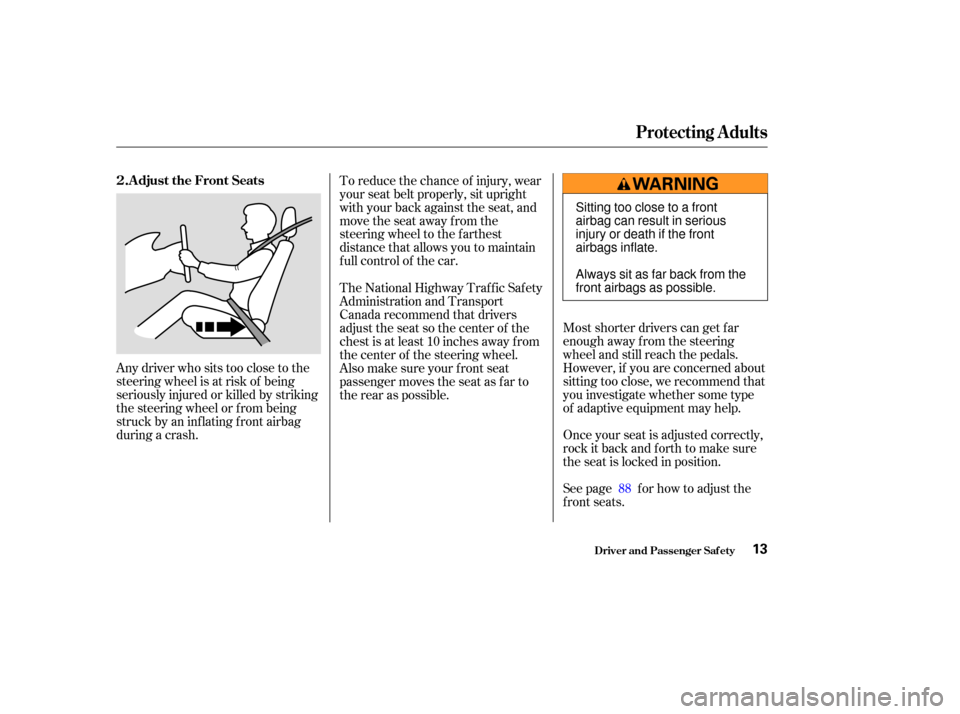steering Acura TL 2003 3.2 Owner's Manual
[x] Cancel search | Manufacturer: ACURA, Model Year: 2003, Model line: TL, Model: Acura TL 2003Pages: 347, PDF Size: 4.14 MB
Page 1 of 347

2003 TL Online Reference Owner's Manual Use these links (and links throughout this manual) to navigate through this reference.
For a printed owner's manual, click on authorized manuals or go to www.helminc.com.
Contents
Owner's Identification Form
Introduction ........................................................................\
............................................................................. i
A Few Words About Safety ........................................................................\
.................................................. ii
Your Vehicle at a Glance ........................................................................\
....................................................... 2
Driver and Passenger Safety ........................................................................\
............................................... 5
Proper use and care of your vehicle's seat belts, and Supplemental Restraint System.
Instruments and Controls........................................................................\
...................................................55
Instrument panel indica tor and gauge, and how to use dashboard and steering column controls.
Comfort and Convenience Features........................................................................\
............................... 115
How to operate the climate control system, the audio system, and other convenience features.
Before Driving ........................................................................\
....................................................... ..............173
What gasoline to use, how to break-in your new vehicle, and how to load luggage and other cargo.
Driving........................................................................\
...................................................................................187
The proper way to start the engine, shift the tr ansmission, and park, plus towing a trailer.
Maintenance........................................................................\
....................................................... ..................219
The Maintenance Schedule shows you when you need to take your vehicle to the dealer.
Appearance Care........................................................................\
....................................................... ..........279
Tips on cleaning and protecting your vehicle. Things to look for if your car ever needs body repairs.
Taking Care of the Unexpected........................................................................\
.......................................287
This section covers several problems motorists someti mes experience, and how to handle them.
Technical Information........................................................................\
....................................................... 315
ID numbers, dimensions, capaciti es, and technical information.
Warranty and Customer Relations (U.S. and Canada)...................................................................... 329
A summary of the warranties covering your new Honda, and how to contact us.
Authorized Manuals (U.S. only)........................................................................\
....................................... 333
How to order manuals and other technical literature.
Index ........................................................................\
......................................................................................... I
Service Information Summary
A summary of information you need when you pull up to
the fuel pump.
Page 8 of 347

This section gives you important
inf ormation about how to protect
yourself and your passengers. It
shows you how to use seat belts
properly. It explains your Supple-
mental Restraint System. And it tells
you how to properly restrain inf ants
andchildreninyourcar..........
Important Safety Precautions . 6
.............
Your Car’s Saf ety Features . 7
.......................................
Seat Belts .8
...........................................
Airbags .9
.....................
Seats & Seat-Backs .10
..........................
Head Restraints .10
..................................
Door Locks .10
........
Pre-Drive Saf ety Checklist . 11
............................
Protecting Adults .12
.....
1. Close and Lock the Doors . 12 ...........
2. Adjust the Front Seats . 13
............
3. Adjust the Seat-Backs . 14
...
4. Adjust the Head Restraints . 15
5. Fasten and Position the Seat .....................................
Belts .15
....
6. Adjust the Steering Wheel . 18
7. Maintain a Proper Sitting ................................
Position .18
.....
Advice f or Pregnant Women . 19
...
Additional Safety Precautions . 20
........................
Protecting Children .21
All Children Must Be ...............................
Restrained .21
Children Should Sit in the Back ...........................................
Seat .22
The Passenger’s Front Airbag Poses Serious Risks ...........................
to Children .22
If You Must Drive with Several ...................................
Children .25
If a Child Requires Close ..................................
Attention .25
...
Additional Safety Precautions . 25
General Guidelines f or Using ...............................
Child Seats .26
.......................
Protecting Inf ants .30 .........
Protecting Small Children . 33
.......
Protecting Larger Children . 37
Using Child Seats with .....................................
Tethers .41
.............................
Using LATCH .42
Additional Inf ormation About Your .................................
Seat Belts .44
..
Seat Belt System Components . 44
......................
Lap/Shoulder Belt .44
Automatic Seat Belt ...............................
Tensioners .45
...............
Seat Belt Maintenance . 46
Additional Inf ormation About Your .....................................
Airbags .47
........................
SRS Components .47
How Your Front Airbags .........................................
Work .47
...
How Your Side Airbags Work . 49
How the SRS Indicator Light .......................................
Works .50
How The Side Airbag Indicator ............................
Light Works .51
.............................
Airbag Service .52
...
Additional Safety Precautions . 52
.............
Carbon Monoxide Hazard . 53
...................................
Saf ety Labels .54
Driver and Passenger Saf ety
Driver and Passenger Saf ety
5
Page 10 of 347

Your car is equipped with many
features that work together to
protect you and your passengers
during a crash.
Some saf ety f eatures do not require
anyactiononyourpart.These
include a strong steel f ramework
that forms a safety cage around the
passenger compartment; f ront and
rear crush zones that are designed to
crumple and absorb energy during a
crash; a collapsible steering column;
and seat belt tensioners that
automatically tighten the front seat
belts in the event of a crash.
CONT INUED
Driver and Passenger Saf ety
Your Car’s Saf ety Features
7
( (5
5) )(
(
7
7) )(
(
6
6) )
(
( 2
2) ) (
(
2
2) )
(
(
1
1) )
(
( 3
3) )
(
( 8
8) )
(
( 7
7) ) (
(
4
4) )
(
( 9
9) )
(
(1
10 0))
(
(
9
9) )(
(1
1) ) S
Sa affe
et tyy C
Caagg e
e
(
( 2
2) ) C
Cr ruu s
shh Z
Zo
on
ne
ess
(
( 3
3) ) S
Se eaattss &
& S
Seeaatt--B
Ba acckks s
(
( 4
4) ) H
H e
eaadd R
Reessttrraai inn t
tss
(
( 5
5) ) C
Co ol
lllaap p s
siibb l
lee S
Stteee erriinn g
g C
Cool
luu m
m n
n
(
( 6
6) ) S
Se eaatt B
Be elltts s
(
( 7
7) ) F
Frroo n
nt
t A
A i
irrb b a
agg s
s
(
( 8
8) ) D
D o
oo
or
r L
Loo c
ckks s
(
( 9
9) ) S
Si idd e
e A
Ai
irrb b a
agg s
s
(
( 1
10 0)) S
Se eaatt B
Be elltt T
Te
enn s
siioo n
ne
errss
Page 13 of 347

Keeping your doors locked reduces
thechanceof beingthrownoutof
the car during a crash. It also helps
prevent occupants f rom accidentally
opening a door and f alling out, and
outsiders f rom unexpectedly opening
your doors. Head restraints can help protect you
f rom whiplash and other injuries. For
maximum protection, the back of
your head should rest against the
center of the head restraint.Move the f ront
seats as far back as possible, and
keep adjustable seat-backs in an
upright position whenever the car is
moving.
Your car’s seats are designed to keep
you in a comf ortable, upright
position so you can take f ull
advantage of the protection offered
by seat belts and the energy
absorbing materials in the seats.
How you adjust your seats and seat-
backs can also affect your safety. For
example, sitting too close to the
steering wheel or dashboard
increases the risk of you or your
passenger being injured by striking
theinsideof thecar,orbyan
inf lating airbag.
Reclining a seat-back too f ar reduces
the seat belt’s ef f ectiveness and
increases the chance that the seat’s
occupant will slide under the seat
belt in a crash and be seriously
injured.
To do their job, airbags must
inf late with tremendous f orce and
speed. So while airbags help save
lives, they can cause minor injuries,
or more serious or even fatal
injuries if occupants are not
properly restrained or sitting
properly.
Always wear
your seat belt properly, and sit
upright and as f ar back as possible
f rom the steering wheel or
dashboard.
Driver and Passenger Saf ety
Your Car’s Saf ety Features
Door L ocks Head Restraints
Seats & Seat-Backs
What you should do:
A irbags of f er no prot ect ion in rear
impact s, rollovers, or minorf ront al or side collisions.
Airbags can pose serious hazards.
What you should do:
10
Page 14 of 347

All adults, and children who have
outgrown child saf ety seats, are
wearing their seat belts and
wearingthemproperly(seepage).
Any inf ant or small child is
properly restrained in a child seat
inthebackseat(seepage ).
To make sure you and your
passengers get the maximum
protection f rom your car’s saf ety
f eatures, check the f ollowing each
time before you drive away:
The rest of this section gives more
detailed inf ormation about how you
can maximize your saf ety.
Remember, however, that no saf ety
system can prevent all injuries or
deaths that can occur in severe
crashes, even when seat belts are
properly worn and the airbags deploy.
Head restraints are properly
adjusted (see page ).
All doors are closed and locked
(see page ). Frontseatoccupantsaresitting
upright and as f ar back as possible
f rom the steering wheel and
dashboard (see page ).
All cargo is properly stored or
secured (see page ). Seat-backs are upright (see page
).
12
15
21 13
14 15
183
Driver and Passenger Saf ety
Pre-Drive Saf ety Checklist
Your Car’s Saf ety Features
11
Page 16 of 347

Any driver who sits too close to the
steering wheel is at risk of being
seriously injured or killed by striking
the steering wheel or f rom being
struck by an inflating front airbag
during a crash.To reduce the chance of injury, wear
your seat belt properly, sit upright
with your back against the seat, and
movetheseatawayfromthe
steering wheel to the f arthest
distance that allows you to maintain
f ull control of the car.
See page f or how to adjust the
f ront seats. Once your seat is adjusted correctly,
rock it back and f orth to make sure
the seat is locked in position. Most shorter drivers can get f ar
enough away f rom the steering
wheel and still reach the pedals.
However, if you are concerned about
sitting too close, we recommend that
you investigate whether some type
of adaptive equipment may help.
The National Highway Traffic Safety
Administration and Transport
Canada recommend that drivers
adjust the seat so the center of the
chest is at least 10 inches away f rom
the center of the steering wheel.
Also make sure your f ront seat
passenger moves the seat as f ar to
the rear as possible.
88
Driver and Passenger Saf ety
Protecting Adults
Adjust the Front Seats
2.
13
Sitting too close to a front
airbag can result in serious
injury or death if the front
airbags inflate.
Always sit as far back from the
front airbags as possible.
Page 17 of 347

See page f or how to adjust seat-
backs.
A f ront passenger should also adjust
the seat-back to an upright position,
but as f ar f rom the dashboard as
possible. A passenger who sits too
close to the dashboard could be
injured if the f ront airbag inf lates.
Reclining a seat-back so that the
shoulder part of the belt no longer
rests against the occupant’s chest
reduces the protective capability of
the belt. It also increases the chance
of sliding under the belt in a crash
and being seriously injured. The
farther a seat-back is reclined, the
greater the risk of injury.
Adjust the driver’s seat-back to a
comf ortable, upright position,
leaving ample space between your
chest and the airbag cover in the
center of the steering wheel. If you
sit too close to the steering wheel,
you could be injured if the f ront
airbag inflates. 89
Driver and Passenger Saf ety
Protecting Adults
Adjust the Seat-Backs
3.
14
Reclining the seat-back too far
can result in serious injury or
death in a crash.
Adjust the seat-back to an
upright position and sit well
back in the seat.
Page 21 of 347

Adjust the steering wheel, if needed,
so that the wheel points toward your
chest, not toward your f ace.
Pointing the steering wheel toward
your chest provides optimal
protection f rom the airbag.
See page f or how to adjust the
steering wheel.After all occupants have adjusted
their seats and put on seat belts, it is
very important that they continue to
sit upright, well back in their seats,
with their feet on the floor, until the
car is parked and the engine is of f .
Sitting improperly can increase the
chance of injury during a crash. For
example, if an occupant slouches,
lies down, turns sideways, sits
forward, leans forward or sideways,
or puts one or both f eet up, the
chance of injury during a crash is
greatly increased.
In addition, an occupant who is out of
position in the f ront seat can be
seriously or f atally injured by
striking interior parts of the car, or
by being struck by an inf lating f ront
airbag. Being struck by an inflating
side airbag can result in possibly
serious injuries.
75
Adjust the Steering Wheel
Maintain a Proper Sitting
Position
6.
7.
Protecting Adults
Driver and Passenger Saf ety18
Sitting improperly or out of
position can result in serious
injury or death in a crash.
Always sit upright, well back in
the seat, with your feet on the
floor.
Page 22 of 347

Because protecting the mother is the
best way to protect her unborn child,
a pregnant woman should always
wear a seat belt whenever she drives
or rides in a car.Pregnant women should also sit
upright and as f ar back as possible
f rom the steering wheel or
dashboard. This will reduce the risk
of injuries to both the mother and
her unborn child that can be caused
by a crash or an inf lating airbag.
Each time you have a check-up, ask
your doctor if it’s okay f or you to
drive.
Remember to keep the lap portion of
the belt as low as possible across
your hips.
Remember, to get the best
protection f rom your car’s airbags
and other safety features, you must
sit properly and wear your seat belt
properly.
Advice f or Pregnant Women
Protecting Adults
Driver and Passenger Saf ety19
Page 23 of 347

If they do, they
could be very seriously injured in a
crash.
Devices intended to improve
occupant comf ort or reposition the
shoulder part of a seat belt can
severely compromise the
protective capability of the seat
belt and increase the chance of
serious injury in a crash. Carrying hard or sharp
objects on your lap, or driving with
a pipe or other sharp object in
your mouth, can result in injuries
if your f ront airbag inf lates. If a side airbag
inflates,acupholderorotherhard
object attached on or near the
door could be propelled inside the
car and hurt someone.
If your
hands or arms are close to the
airbag cover in the center of the
steering wheel or on top of the
dashboard, they could be injured if
the front airbag inflates.
Any object
attached to or placed on the covers
marked ‘‘SRS AIRBAG’’ in the
center of the steering wheel and
on top of the dashboard could
interf ere with the proper operation
of the airbags. Or, if the airbags
inf late, the objects could be
propelled inside the car and hurt
someone.
Additional Saf ety Precautions
T wo people should never use t he
same seat belt .
Do not put any accessories on seatbelts. Do not place hard or sharp object s
bet ween yourself and a f rontairbag. Do not at t ach hard object s on or
near a f ront door.
K eep your hands and arms awayf rom t he airbag covers.
Do not at t ach or place object s on
the f ront airbag covers.
Protecting Adults
Driver and Passenger Saf ety20